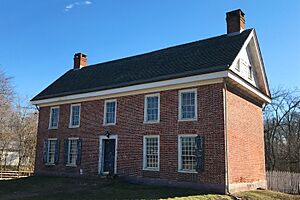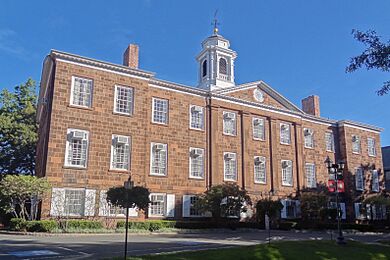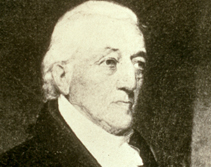History of Rutgers University facts for kids
Rutgers University, officially called Rutgers, The State University of New Jersey, is a large school with campuses across New Jersey. Its main campuses are in New Brunswick and Piscataway. It also has campuses in Newark and Camden.
Rutgers was one of the first nine colleges started during the American colonial period. It began as Queen's College on November 10, 1766. In 1825, it was renamed Rutgers College to honor Colonel Henry Rutgers (1745–1830). He was a hero from the American Revolutionary War and a generous supporter of the school. Later, in 1924, it became Rutgers University.
Rutgers started as a private school connected to the Dutch Reformed Church. Today, it is a public university for the state of New Jersey. This happened through laws passed in 1945 and 1956. Rutgers is special because it is the only university in the United States that is a colonial college (from 1766), a land-grant institution (from 1864), and a state university (from 1945/1956).
Contents
History of Rutgers University
Starting Queen's College

After Princeton University was created in 1746, ministers of the Dutch Reformed Church wanted to start their own college. At that time, future ministers had to travel all the way to the Netherlands for training. Many church matters in the American colonies were also handled from Europe. The ministers wanted to create a local group, called a classis, to manage church affairs in the colonies.
A religious movement in the 1700s, called the Great Awakening, helped lead to the idea of Queen's College. This movement made people like Theodorus Jacobus Frelinghuysen want more independence from the church in Amsterdam. Protestant churches, including the Dutch Reformed Church, wanted to train ministers in the colonies. This would avoid the long, expensive, and difficult trip to Europe. More ministers were needed as churches grew during the Great Awakening.
In the 1750s, Dutch ministers worked to create a classis in the colonies. Theodorus Jacobus Frelinghuysen II traveled to many churches to gather support. He then went to the Netherlands to ask the Dutch Reformed Church's main council for approval. When this failed in 1761, he sailed back to the colonies but sadly disappeared at sea near New York City.
After Frelinghuysen's death, Jacob Rutsen Hardenbergh became a strong voice for starting a college in New Jersey. He traveled to Europe to try again for approval, but was also turned down. Hardenbergh then asked King George III of Great Britain for help. On November 10, 1766, William Franklin, the royal governor of New Jersey, officially approved the charter for Queen's College. Many important people supported this new school.
Many buildings at Rutgers today are named after these early supporters. These include John Hardenbergh (the first president), John Henry Livingston, Phillip Milledoler, Henry Rutgers (who the college was named after), and Theodore Frelinghuysen.
Some early leaders and supporters of Queen's College had connections to slavery. They included people like Philip Livingston, Robert Livingston, and Jacob Hardenbergh. Some of the college's first students also came from families in the area who owned slaves. The college also received money and land from people who owned slaves, such as James Parker and Henry Rutgers.
Queen's College Opens
The school, now known as Rutgers, was officially started on November 10, 1766. It was named "the trustees of Queen's College, in New-Jersey" to honor Charlotte of Mecklenburg-Strelitz, the queen of King George III. The charter was signed by William Franklin, the last Royal Governor of New Jersey and son of Benjamin Franklin. The original plan included both the college and a preparatory school, the Queen's College Grammar School. This school, now the Rutgers Preparatory School, was part of the college until 1957.
The main goal of Queen's College was to "educate the youth in language, liberal, the divinity, and useful arts and sciences." It also aimed to train future ministers for the Dutch Reformed Church. Today, the university is not religious and does not require students to follow any faith. In May 1771, the leaders decided to build the college in New Brunswick. They chose it over Hackensack, New Jersey.
The school welcomed its first students in 1771. There was one sophomore and a few first-year students. They were taught by a single teacher, Frederick Frelinghuysen. The first degree was given in 1774 to Matthew Leydt. Even though other universities accepted Native American students, Queen's College chose not to.
At first, Queen's College held classes in a tavern called the Sign of the Red Lion. This was in New Brunswick, where the Johnson & Johnson headquarters are today. When the American Revolutionary War started, British soldiers suspected taverns of being rebel meeting places. So, the college moved classes to private homes in and around New Brunswick.
In its early years, Queen's College struggled to find enough money. In 1793, the leaders thought about joining with the College of New Jersey (now Princeton University). This idea failed by just one vote. The money problems continued, and in 1795, the college closed down. It reopened in 1808 after supporters raised $12,000.

The next year, the college got its own building, called "Old Queens". This building is still standing today. It was designed by architect John McComb, who also designed City Hall in Manhattan. Experts say it is a great example of Federal architecture. The college's third president, Rev. Ira Condict, laid the first stone on April 27, 1809. However, money problems delayed finishing the building for 14 years.
The New Brunswick Theological Seminary, started in 1784, moved to New Brunswick in 1810. It shared buildings with Queen's College. All three institutions were in the Old Queens Building, which was the only building on campus then. In 1815, Elias Van Bunschooten gave the college almost $19,000. This was one of the biggest donations at the time. It helped the college with its money problems after being closed from 1795 to 1807. Donations from people like him, Andrew Kirkpatrick, and Ira Condict helped save the college.
As the college grew, it focused on a classic liberal arts education. The seminary also grew, and the buildings became too crowded. So, in 1856, the seminary moved to its own land nearby. Both schools still have a close relationship today. The seminary's library is part of the Rutgers University Library system.
Becoming Rutgers University
A nationwide money crisis and the War of 1812 forced Queen's College to close again in 1816. In 1825, Queen's College reopened. Its name was changed to "Rutgers College" to honor Colonel Henry Rutgers (1745–1830). He was an American Revolutionary War hero. The school leaders chose him because he showed strong values and was a rich man known for giving to charity.
A year after the name change, Colonel Rutgers gave two gifts to the school. He gave a $200 bell that still hangs in the Old Queen's building. Then, in 1826, he donated the interest from a $5,000 bond. This second gift finally gave the college the steady money it needed. The college's early struggles inspired many student songs. One song adapted a drinking song with the words: "Here's a toast to old Rutgers, loyal men/May she ne'er go down but to rise again."
Rutgers College became New Jersey's land-grant college in 1864. This happened under the Morrill Act of 1862. This act gave federal money to help develop schools for agriculture. This led to the creation of the Rutgers Scientific School. It had departments for agriculture, engineering, and chemistry. The land given through this act had belonged to the Lenni Lenape people. They had been moved to the West and were not asked about using the land.
The sciences continued to grow at Rutgers. The New Jersey Agricultural Experiment Station was started in 1880. The Rutgers Scientific School later split into the College of Engineering (now the School of Engineering) in 1914. The College of Agriculture (now the School of Environmental and Biological Sciences) was formed in 1921. Other parts of Rutgers also began during this time. These included the College of Pharmacy (now the Ernest Mario School of Pharmacy) in 1892. The New Jersey College for Women (now Douglass Residential College) started in 1918. The School of Education began in 1924. Later, University College was created for part-time students. Livingston College was made to focus on the urban experience.
Besides academics, the sport of college football is said to have started at Rutgers. The 1869 New Jersey vs. Rutgers football game is called the first American football game ever played. Rutgers won that game 6–4.
The first Summer Session at Rutgers began in 1913. It was a six-week program with 47 courses and 314 students. Today, Summer Session offers over 1,000 courses. More than 15,000 students take these classes on the Camden, Newark, and New Brunswick/Piscataway campuses. Classes are also offered off-campus and abroad.
Rutgers College was officially renamed Rutgers University in 1924.
Rutgers as a State University
The New Jersey Legislature officially named Rutgers the State University of New Jersey in 1945 and 1956. Before the 1956 law, the school's leaders decided to separate from the Rutgers Preparatory School. The prep school became fully independent in 1957. It moved to a new campus in nearby Somerset, New Jersey. Under the 1956 law, Rutgers would be managed by two groups. The Board of Trustees advises the school and protects its history from the 1766 charter. The Board of Governors has eleven members. Five are chosen by the trustees, and six are appointed by the governor of New Jersey.
Since the 1950s, Rutgers has continued to grow. It has especially expanded its programs for advanced degrees. New schools have been created for subjects like business, management, public policy, social work, psychology, the fine arts, and communication and library studies. Many of these schools also offer programs for undergraduate students.
In 1947 and 1966, the College Avenue Gymnasium hosted New Jersey's Constitutional Conventions. This building is on the site of the first intercollegiate football game.
During the 1960s and 1970s, many male-only colleges started accepting women. This was part of a national trend due to the civil rights and women's rights movements. Rutgers, like many older American schools such as Princeton and Yale, became coeducational. On September 10, 1970, after much discussion, the Board of Governors voted to allow women into the previously all-male Rutgers College. Today, Douglass Residential College (which was originally the New Jersey College for Women) is still all-female. The rest of the university is coeducational.
In 2002, former Governor James E. McGreevey formed a committee to look into combining Rutgers University with the New Jersey Institute of Technology (NJIT) and the University of Medicine and Dentistry of New Jersey (UMDNJ). The committee suggested this merger. They said it would help the schools get more money for medical, scientific, and technology research. However, students, teachers, and alumni did not like this plan. Governor McGreevey eventually stopped the merger idea.
In 2012, UMDNJ did merge with Rutgers. This was done by a law from the New Jersey state legislature. It created the Rutgers School of Biomedical and Health Sciences. In 2016, President Barack Obama spoke at the university's graduation ceremony. The next year, Steven Van Zandt was the graduation speaker and received an honorary degree in fine arts.
In February 2021, the University announced a partnership between the Robert Wood Johnson Medical School and RWJBarnabas Health. This is the largest health network in New Jersey. This partnership meant the medical school's patient care would work with RWJBH facilities. This made every hospital in the health network a teaching hospital. It created one of the largest combined health systems in the country. The agreement also included a big investment in the Rutgers Cancer Institute of New Jersey. This included $750 million to build a cancer center in New Brunswick.
On April 9, 2023, three unions at Rutgers voted to go on strike. This was the first strike in the university's 257-year history. They went on strike because they felt talks about their work contracts were not making progress. As a result, classes and research were paused.
See also
- Queens Campus
- Colonial colleges
- Lists of universities and colleges
- List of Rutgers University people
- History of New Jersey
- Public Ivy
- Rutgers University


